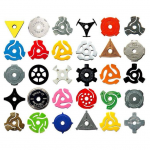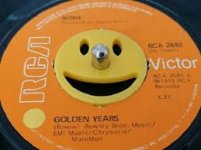I've seen a couple of those shapes but always black and very old.. Amazed to see so much variety and colour. Are you a collector?
When in my teens I regularly visited the market buying pop singles. There were several stalls selling ex-jukebox singles with the middles popped out & replaced with the spring in replacements.
Did 7" 45s always have the pop-out middle for jukebox use?
The earliest jukeboxes played 78s. I don't remember those having the pop-out middle.
I do remember the jukeboxes played in song order, up the A sides, down the B sides. Not in the the order tunes were selected. On a night out in town, no point selecting a tune that wouldn't be played for another hour, You'd be 3 pubs & 3 pints away by the time it got played!
Did 7" 45s always have the pop-out middle for jukebox use?
The earliest jukeboxes played 78s. I don't remember those having the pop-out middle.
I do remember the jukeboxes played in song order, up the A sides, down the B sides. Not in the the order tunes were selected. On a night out in town, no point selecting a tune that wouldn't be played for another hour, You'd be 3 pubs & 3 pints away by the time it got played!
I remember the fourth in the top row from my youth but my old cheap Technics came with a plastic puck and my just as old but considerably more expensive Thorens with a machined aluminium one.
RCA invented the 45 as a complete system with *changer*. That's why the monster hole: all the contraption was inside the spindle, no overhead arm to steady the stack. It gave quality potentially comparable to LP at price similar to one 78, ideal for "singles". But also possible to program longer works on multiple discs, like 78s.
Because the record would be played so often in a jukebox, wear in a small spindle hole would be a problem. There is an advantage of the larger hole when used in a jukeboxWasnt the big hole for Juke boxes ?
Why is the Hole on a 45 RPM Record So Big? - Alan Cross' A Journal of Musical ThingsThere was a more scientific reason for the larger hole. When a new 45 dropped from the spindle onto the turntable, it was required to spin up from a dead stop to 45 RPM very quickly. This torque tended to cause the small holes to go out-of-round very quickly, causing the record to wobble as it spun. The larger hole allowed the sudden rotational force to be distributed over a longer path - pi x 1.5 = about 4.712 inches - reducing wear and allowing the hole to stay round longer.
> The larger hole allowed the sudden rotational force to be distributed over a longer path—pi x 1.5 = about 4.712 inches—reducing wear and allowing the hole to stay round longer.
I call BS on this. Usually the spindle does not rub the record, more than momentarily. And most multi-format changers have a stationary 45 adapter (if it hasn't got lost).
I call BS on this. Usually the spindle does not rub the record, more than momentarily. And most multi-format changers have a stationary 45 adapter (if it hasn't got lost).
When I grew up with 45s in the 1970s they always had the larger spindle hole. Kid record players had a popup spindle enlarger for 45s. Had to use adaptors for turntables with a small spindle.
Never saw a 45 with a small spindle hole in the US.
Never saw a 45 with a small spindle hole in the US.
It was all about being IN-compatable. RCA and Sarnoff could be real butt-heads. You know they systematically broke-down all of Farnsworth TV patents just so Sarnoff wouldn't pay royalties.
Last edited:
Attachments
I’m with PRR. I had a 78 playing jukebox and the spindle rotated with the record. It also clamped the record to the small “turntable” the size of the record label. There would be no slippage IMHO. Possibly 45 jukeboxes were different but I doubt it.
In about 1967 I was at a party and a girl brought her portable record player and a stack of ‘45s. And yes it had a tall fat center post that didn’t require an arm to hold the disks in place, yet was a changer. I was surprised because everyone I knew just bought LPs but apparently singles were still a “thing”.
It makes a lot of sense that a simple changer that would allow you to make up a “playlist”
and not have to change manually after every song would be a good idea.
My much younger siblings had a slot loading player that used the ‘45s with the big holes one at a me Worked great. Made by Playshool I think
In about 1967 I was at a party and a girl brought her portable record player and a stack of ‘45s. And yes it had a tall fat center post that didn’t require an arm to hold the disks in place, yet was a changer. I was surprised because everyone I knew just bought LPs but apparently singles were still a “thing”.
It makes a lot of sense that a simple changer that would allow you to make up a “playlist”
and not have to change manually after every song would be a good idea.
My much younger siblings had a slot loading player that used the ‘45s with the big holes one at a me Worked great. Made by Playshool I think
Last edited:
Slot loading players were very common in Italy when I was a teenager, and my youngest sister had several of them in a few years. Italian 45s like the ones sold in the U.S. all had the large hole, I later discovered this was not universally true, finding disks in the UK and Germany that had the standard sized hole. (Those slot loaders wore out very quickly, and I spent a lot of time fixing them in their last days.. LOL)
I seem to recall you could purchase a special tool (ducking tool??) in UK record stores expressly to punch the hole in a 45 required by a juke box.
RCA and Columbia were involved in a format war at the end of the 1940s and RCA was offered the 33 1/3rd RPM disk by Columbia and refused it and countered with their 45 RPM disk. By about 1950 the battle was over and RCA accepted the inevitable and started making 33 1/3rd rpm disks. (And others started making 45 rpm singles)
RCA sold albums on sets of 45 rpm disks for a few years with color coded disks by music category. I guess those that remain have become collectable.
Can you imagine the music scene of the 1960s had LPs not existed, the concept album that became commonplace in rock music and other genres would have been a whole lot less convenient or maybe would not have happened at all?
I seem to recall you could purchase a special tool (ducking tool??) in UK record stores expressly to punch the hole in a 45 required by a juke box.
RCA and Columbia were involved in a format war at the end of the 1940s and RCA was offered the 33 1/3rd RPM disk by Columbia and refused it and countered with their 45 RPM disk. By about 1950 the battle was over and RCA accepted the inevitable and started making 33 1/3rd rpm disks. (And others started making 45 rpm singles)
RCA sold albums on sets of 45 rpm disks for a few years with color coded disks by music category. I guess those that remain have become collectable.
Can you imagine the music scene of the 1960s had LPs not existed, the concept album that became commonplace in rock music and other genres would have been a whole lot less convenient or maybe would not have happened at all?
- Home
- Member Areas
- The Lounge
- age test


